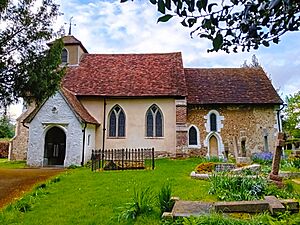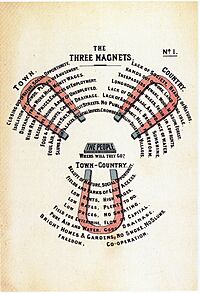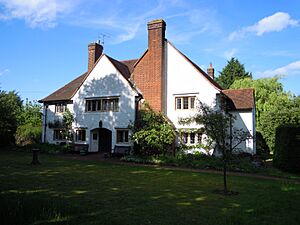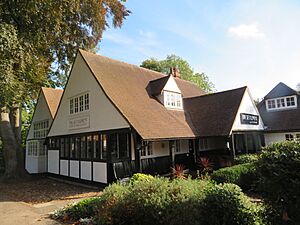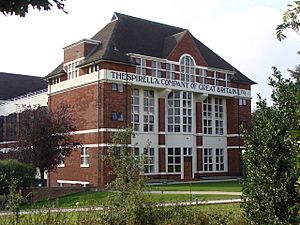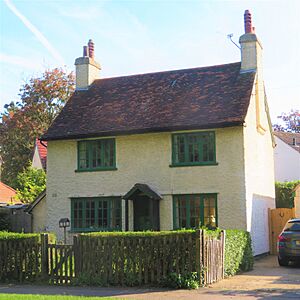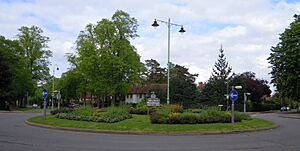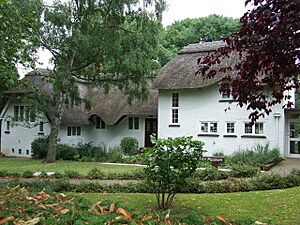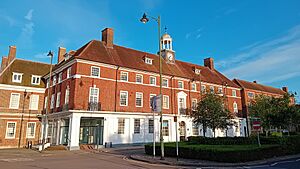Letchworth facts for kids
Quick facts for kids Letchworth Garden City |
|
|---|---|
| Town | |
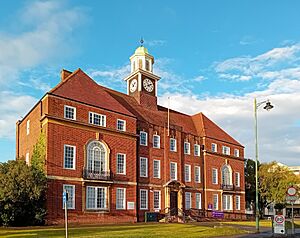 Letchworth Town Hall |
|
| Population | 33,990 (Built up area, 2021) |
| OS grid reference | TL215325 |
| District |
|
| Shire county | |
| Region | |
| Country | England |
| Sovereign state | United Kingdom |
| Post town | Letchworth Garden City |
| Postcode district | SG6 |
| Dialling code | 01462 |
| Police | Hertfordshire |
| Fire | Hertfordshire |
| Ambulance | East of England |
| EU Parliament | East of England |
| UK Parliament |
|
Letchworth Garden City, often called Letchworth, is a town in Hertfordshire, England. It's famous for being the world's very first "garden city." This means it was specially planned to combine the best parts of city life with the beauty of the countryside. In 2021, about 33,990 people lived here.
Letchworth was once a small village mentioned in the Domesday Book way back in 1086. It stayed small until the early 1900s. The modern town began in 1903 when a company called First Garden City Limited bought a lot of land. This company was started by Ebenezer Howard and his friends. They wanted to build a new kind of town based on Howard's ideas from his 1898 book, To-morrow: A Peaceful Path to Real Reform. Their goal was to create a place with jobs, services, and good homes, but also with lots of green spaces, unlike the busy, often polluted, industrial cities of that time.
The town's first design was created by Raymond Unwin and Barry Parker. It even has the United Kingdom's first ever roundabout, called Sollershott Circus, built around 1909. Letchworth's design includes many parks and open areas, like Norton Common and Howard Park.
In 1960, a different company took over First Garden City Limited. This led to big changes that many residents didn't like. They wanted to keep the original garden city ideas. So, they worked to pass a special law in Parliament. This law transferred the town's ownership to a public group called the Letchworth Garden City Corporation in 1963. Later, in 1995, a charity called the Letchworth Garden City Heritage Foundation took over. This charity still owns and manages the town's estate today.
Today, Letchworth has many businesses that provide jobs. The money made from these businesses is used by the Heritage Foundation to help the community. The town is about 32 miles (51 km) north of London. It's on the railway line to Cambridge and is also close to the A1 road. This makes it a popular place for people who travel to work. Letchworth has different types of homes. Many areas are protected as "conservation areas" because of their special quality. However, some parts of the town have fewer resources compared to other areas in North Hertfordshire.
As the world's first garden city, Letchworth has had a big impact on how towns are planned. It inspired nearby Welwyn Garden City, which used similar ideas. Parts of Letchworth's design have also been used in other projects around the world. These include Canberra in Australia, Hellerau in Germany, Tapiola in Finland, and Mežaparks in Latvia.
Contents
History of Letchworth
Before the Garden City: Old Letchworth
People have lived in the area where Letchworth is now for a very long time, even before recorded history. A very old hill fort from the late Bronze Age (around 700 BC) stood on Wilbury Hill. This fort was used again around 400 BC during the Middle Iron Age and was likely used until the Roman conquest of Britain. Signs of Bronze Age, Roman-British, and late Iron Age settlements have also been found nearby.
By the time of the Norman Conquest in 1066, Letchworth was already a village. Its name comes from old English words meaning "a farm inside a fence." In the Domesday Book of 1086, it was called "Leceworde." It had 9 households, 4 cottagers, 1 slave, and 1 priest. Having a priest suggests it was already a parish. Letchworth's parish church was built in the 12th century, probably on the site of an even older building. The village was located along Letchworth Lane. It was a small parish, with only 67 people in 1801, growing to 96 by 1901.
The Early Days of the Garden City
In 1898, a social reformer named Ebenezer Howard wrote a book called To-morrow: A Peaceful Path to Real Reform. In it, he suggested building a new type of town he called a "garden city." His main idea was shown in a drawing called the "Three Magnets." This drawing explained how to combine the good things about city life and country life into a new option: "Town-Country." This new place would offer the benefits of both, without their downsides. For example, factories would be kept separate from homes. People would also have easy access to parks and the countryside. The garden city would be surrounded by a "green belt" of open land. This land would be used for farming, children's homes, and forests. This idea of a protected rural belt later influenced town planning across Britain.
Some people made fun of Howard's ideas, but many others liked them, especially those in the Arts and Crafts movement and the Quakers. After looking at several places, the garden city founders chose Letchworth. The Letchworth Hall estate was for sale, and by secretly buying land from fourteen other landowners, they gathered 3,818 acres (1,545 hectares) for £155,587. First Garden City Limited was started on September 1, 1903, to buy the land and begin building the garden city.
In 1904, architects Raymond Unwin and Barry Parker won a competition to design the town. They became the main architects for the company. They made sure to keep most of the existing trees and hedges. Unwin even used three old oak trees on the estate's central plateau to line up the town's main street, Broadway. These trees became part of Broadway Gardens, a central square.
A temporary train stop was built in 1903 on the Great Northern Railway line. At first, only special trains for visitors and construction workers used it. A more permanent wooden station opened in 1905 with regular passenger service. The current railway station was built in 1912 at the end of Broadway.
The first new homes were ready in July 1904. The next month, First Garden City Limited asked shareholders and residents to vote on the town's name. Options included "Garden City" and "Homeworth." The chosen name was "Letchworth (Garden City)." The company used this name, but the official name of the local area remained simply "Letchworth." Over time, the company also dropped the "(Garden City)" part, as the town grew beyond being just an experiment. The train station was also renamed "Letchworth" in 1937, but is now called Letchworth Garden City again.
Ebenezer Howard's wife, Lizzie, passed away in London in November 1904, just before she was supposed to move to a new house in Letchworth. To remember her, a public hall was built using money donated by people. The Mrs Howard Memorial Hall opened in 1906 and was one of the town's first public buildings.
In 1905 and 1907, the company held "Cheap Cottages Exhibitions." These were contests for architects and builders to show new ways to build affordable homes. The 1905 exhibition attracted about 60,000 visitors. These popular exhibitions even inspired the Daily Mail to start the Ideal Home Exhibition in 1908. It's thought that Lenin, a famous Russian revolutionary, might have visited Letchworth in May 1907 while in London.
For the first few years, the town's Anglican residents used the old churches in the nearby villages. Many of the town's early settlers were non-conformists, meaning they had different religious views, which fit the town's new and different spirit. The first new place of worship built was the Free Church in 1905. In 1907, the Society of Friends (Quakers) built their Meeting House, called 'Howgills'.
People from outside Letchworth often made fun of its first citizens, seeing them as overly idealistic. For example, the town had a very unusual rule for a British town: it banned the sale of alcohol in public places. This was decided by a public vote in June 1907, where 54% voted against allowing pubs. However, this didn't stop the town from having a "pub" called the Skittles Inn, which opened in March 1907. It was known as the "pub with no beer."
Despite the ban, some pubs from before the Garden City was founded continued to operate on the town's edges, like the Three Horseshoes in Norton. New inns also appeared just outside the town's border. The ban was finally lifted after another vote in 1957. This led to the opening of the Broadway Hotel in 1962, the first pub in the center of the Garden City. More pubs have opened since then, but even today, the town center has fewer pubs than other towns its size.
Industry in Letchworth
One of the most important industries to come to Letchworth early on was the making of corsets. The Spirella Company, an American business, started its British branch in the town in 1910. In 1912, they began building a large factory, the Spirella Building, which was completed in 1920. This building was so noticeable that it was nicknamed "Castle Corset." During the Second World War, the factory also made parachutes and decoding machines.
Letchworth attracted and developed many different types of industries. Other important early businesses included:
- J. M. Dent and Son, a publishing company, moved to Letchworth from London in 1907.
- Kryn & Lahy Steel Foundry was started in 1915 by Belgian refugees. It was even a target for German bombers in World War II.
- Irvin Great Britain, a parachute factory, was set up in 1926.
- Shelvoke and Drewry, a company that made dustcarts and fire engines, was founded in 1922 and operated until 1991.
- Westinghouse Morse Chain Company, which made engine parts, started in Letchworth in 1920.
For many years, the biggest employer was the British Tabulating Machine Company. It moved from London to Letchworth in 1920. This company later merged with others to become International Computers Limited (ICL) in 1969.
A power station was built in the 1920s to provide electricity. It had two coal-fired generators. A gas turbine power station was later built on the site. This power station was taken down in 2007.
During the 1970s and 1980s, many of the town's large factories closed. This led to a time of higher unemployment in the early 1980s. Some of the empty factory sites were turned into business parks and offices. The town's economy then changed from having a few large factories to many smaller office-based businesses.
Housing in Letchworth
Early housing in Letchworth mostly followed the original plan by Unwin and Parker. The first homes were six houses called "Alpha Cottages" on Baldock Road, where people moved in during July 1904. Many of the town's first homes were built east of the town center, close to the main industrial area. These houses were often in a simple cottage style, with cream-painted walls, green doors, and clay-tiled roofs. To the southwest, there were larger, specially designed homes for wealthier families.
After the Second World War, the focus shifted to building large council estates (public housing). Work began on the Grange estate in the north of the town in 1947. This estate included its own primary schools, a recreation ground, a pub, and a shopping center. In 1959, land in the southeast was also bought for the Jackmans estate, another large council estate. This estate was built using the "Radburn principle," which was first used in Radburn, New Jersey. This idea aimed to reduce traffic by having homes face pedestrian-only green paths and open spaces. Cars were parked in special areas behind the houses.
Private housing started more slowly after the Second World War due to rules on building materials. As these rules eased, more private homes were built in the south of the town. This area grew even more with the Lordship and Manor Park estates, which started in 1971. After these were finished in the 1980s, most new housing has been built on land that was already developed, like old school or business sites.
UK's First Roundabout
Letchworth wasn't just innovative in its buildings. The 1904 town plan included a spot where six roads met. In July 1908, plans were made for a circular traffic island at this point, inspired by the Place de l'Étoile in Paris. The Letchworth roundabout was being used by 1910. When it was first built, cars could drive around the middle in both directions. The rule to keep left wasn't added until 1921. It was named "Sollershott Circus" and is known as the first roundabout on a public road in the United Kingdom. In 2006, two signs were put up saying "UK's First Roundabout Built circa 1909." This happened after a local student, Andrew White, campaigned for it as a school project.
Wider Impact of the Garden City
As the world's first garden city, Letchworth greatly influenced town planning and the "new towns movement" in the 20th century. It directly inspired Welwyn Garden City, which Ebenezer Howard founded in 1920 using a similar model. It also influenced Hampstead Garden Suburb, started in 1906 and also designed by Raymond Unwin and Barry Parker. Ideas from Letchworth about mixing town and country were later used in other places around the world. These include the Australian capital Canberra, Hellerau in Germany, Tapanila in Finland, and Mežaparks in Latvia.
Letchworth Today
The ownership of the town's estate changed from First Garden City Limited to the Letchworth Garden City Corporation in 1963. Then, in 1995, the Letchworth Garden City Heritage Foundation took over. The money made from the estate started to be used for the town's benefit in 1973. This led to investments in many town facilities. These include a working farm tourist attraction called Standalone Farm (opened 1980), the North Herts Leisure Centre (1982), and a free hospital, the Ernest Gardiner Day Hospital (1984). The Broadway cinema was greatly improved in 1996, and the Heritage Foundation has also supported projects to make the town center better.
Many parts of the town are in "conservation areas" because they are special and well-preserved. However, some areas, like parts of the Jackmans and Grange estates, have fewer resources. The town has many parks and open spaces. Norton Common and Howard Park are two of the largest. Both have won the Green Flag Award for being well-managed green spaces.
As the town neared its 100th birthday, there was a campaign to officially change its name to "Letchworth Garden City." People argued that since Welwyn Garden City had "Garden City" in its official name, the first garden city should too. The campaign was successful. The railway station's name was changed in 1999, and the SG6 post town officially became Letchworth Garden City in 2003, the town's centenary year.
How Letchworth is Governed
Letchworth has two main levels of local government: North Hertfordshire District Council and Hertfordshire County Council. But Letchworth is special because it also has a private charity, the Letchworth Garden City Heritage Foundation. This charity manages many parts of the garden city estate. It has some roles similar to local councils, like helping with planning and giving grants. These roles come from the Heritage Foundation owning the estate. They work alongside, not instead of, the usual local council duties.
Managing the Garden City Estate
The way Letchworth is managed today comes from one of its founding ideas: that any money made from the town should be used to help the people who live there.
First Garden City Limited (1903–1962)
First Garden City Limited was started in 1903 to buy the land and build the town. The plan was that once the garden city was mostly built, the estate would be given to a public group to manage for the community's benefit. Until then, shareholders could only receive a small profit (no more than 5% per year). This made it a very unusual company.
Before World War II, the company largely ran the growing town. It worked closely with the local councils to get approvals for its plans. The company's design plan wasn't a legal planning document, but it showed how the private landowner wanted to develop its land.
After World War II, the relationship between the company and the council started to change. Councils gained more power in town planning. In 1949, the company changed its rules. It said that if the company closed down, only 10% of any extra money would go to the town, instead of the 100% planned in 1903. The rest would go to the shareholders. In 1956, limits on shareholder profits were removed. The company chairman said there was "no binding obligation" to follow the original plan.
Because of this, shares in the company became much more valuable. In 1960, a company called Hotel York Limited bought enough shares to control First Garden City Limited. The town worried that this new owner might sell off parts of Letchworth, and that the town would not get the financial benefits Ebenezer Howard had planned. Even though the new owner first promised to keep the estate together, this didn't last long. In 1961, First Garden City Limited started selling off parts of the estate. The company also suggested that much of the town's surrounding farmland could be built on, allowing the town to grow to 60,000 people instead of the planned 32,000.
Letchworth Garden City Corporation (1963–1995)
| Letchworth Garden City Corporation Act 1962 | |
|---|---|
| Act of Parliament | |

|
|
| Long title | An Act to constitute the Letchworth Garden City Corporation, to transfer to that Corporation the undertaking of First Garden City Limited, to confer powers upon the Corporation; and for other purposes. |
| Citation | 10 & 11 Eliz. 2. c. xxxix |
| Dates | |
| Royal assent | 1 August 1962 |
|
Status: Current legislation
|
|
| Text of the Letchworth Garden City Corporation Act 1962 as in force today (including any amendments) within the United Kingdom, from legislation.gov.uk | |
In response, the local council started a campaign to bring back the original spirit of the garden city. They got help from their local Member of Parliament. Despite strong opposition from Hotel York Limited, a law was passed called the Letchworth Garden City Corporation Act 1962. This law created a public group, the Letchworth Garden City Corporation. On January 1, 1963, this corporation took over the garden city estate. The corporation had to pay First Garden City Limited £3,115,000 for its assets. Paying this money meant the corporation lost money for its first few years, using loans from the council. The debt was paid off in 1973. Finally, the estate started making a profit that could be used to help the town, just as Howard had hoped.
The corporation tried to avoid a new law, the Leasehold Reform Act 1967, which gave people who leased their homes the right to buy them. But they were unsuccessful. So, a "scheme of management" was put in place. This allowed the corporation to control changes made to properties that had been bought outright. These permissions are needed in addition to any planning permission from the council. This scheme didn't apply to parts of the estate where the land had already been sold, like the Grange and Jackmans estates.
Letchworth Garden City Heritage Foundation (1995–present)
The Letchworth Garden City Heritage Foundation Act 1995 replaced the public corporation with the Letchworth Garden City Heritage Foundation (LGCHF). This is a charity that manages the estate.
The Heritage Foundation keeps most of the old corporation's roles and responsibilities. It continues to use the scheme of management for new building plans on the estate. Even though it's a private organization, it has a way for local people to have a say. Six of its thirty governors are directly elected by residents, and ten are chosen to represent different groups in the town. The other fourteen governors are appointed by the board of trustees.
While many homes have been sold since 1967, the Heritage Foundation still owns most of the town's industrial, office, and retail buildings, as well as the surrounding farmland.
So, the Letchworth Garden City estate is owned by a charity. This charity is meant to help the town's residents. In 2020, its assets were worth £193 million. The money it earns is put back into the community to support its charitable goals. In 2020, about £6 million was spent on community benefits.
Geography and Climate
Climate in Letchworth
Letchworth has an oceanic climate, which is typical for most of the United Kingdom. This means it has mild winters and cool summers, with rain throughout the year.
| Climate data for Climate data from Letchworth | |||||||||||||
|---|---|---|---|---|---|---|---|---|---|---|---|---|---|
| Month | Jan | Feb | Mar | Apr | May | Jun | Jul | Aug | Sep | Oct | Nov | Dec | Year |
| Mean daily maximum °C (°F) | 6.7 (44.1) |
7.0 (44.6) |
9.9 (49.8) |
12.7 (54.9) |
16.1 (61.0) |
19.2 (66.6) |
21.8 (71.2) |
21.6 (70.9) |
18.3 (64.9) |
14.1 (57.4) |
9.7 (49.5) |
6.9 (44.4) |
13.7 (56.7) |
| Mean daily minimum °C (°F) | 1.2 (34.2) |
1.0 (33.8) |
2.7 (36.9) |
4.0 (39.2) |
6.9 (44.4) |
9.8 (49.6) |
11.9 (53.4) |
11.8 (53.2) |
9.9 (49.8) |
7.1 (44.8) |
3.8 (38.8) |
1.6 (34.9) |
6.0 (42.8) |
| Average precipitation mm (inches) | 67.0 (2.64) |
47.7 (1.88) |
49.1 (1.93) |
54.1 (2.13) |
52.0 (2.05) |
52.7 (2.07) |
48.8 (1.92) |
62.5 (2.46) |
57.2 (2.25) |
81.1 (3.19) |
75.0 (2.95) |
65.1 (2.56) |
712.3 (28.04) |
| Average precipitation days | 12.1 | 9.4 | 10.2 | 10.2 | 8.8 | 8.6 | 8.0 | 8.8 | 8.9 | 11.0 | 11.6 | 11.0 | 118.5 |
| Mean monthly sunshine hours | 60.6 | 77.3 | 111.7 | 159.9 | 193.9 | 199.1 | 207.1 | 199.1 | 143.7 | 113.2 | 69.1 | 50.6 | 1,585.3 |
Letchworth was hit by a small tornado (an F1/T2 tornado) on November 23, 1981. This was part of a record-breaking tornado outbreak across the UK that day.
Wildlife in Letchworth
Letchworth Garden City is home to one of the UK's largest groups of black squirrels. They were first seen in Letchworth in 1912. Scientists believe these black squirrels are a type of the common North American grey squirrel, but with a gene that affects their fur color. Black squirrels are now a common sight in Letchworth and the areas around it.
You can also find muntjac deer in the town. They mostly live on Norton Common but are sometimes seen in other places too.
Sport and Leisure
Sports have always been important in Letchworth. The town's design included open spaces and playing fields. Many early businesses provided sports facilities for their employees, following the garden city idea. The town has many sports clubs, mostly for amateurs. Many of these clubs compete in regional and national leagues. Popular sports in Letchworth include:
- Cricket - Letchworth Garden City Cricket Club started in 1905. They have five men's teams and several junior teams.
- Football - The town's main football club is Letchworth Garden City Eagles. The Hertfordshire Football Association is also based here.
- Golf - Letchworth Golf Club was founded in 1905. It has an 18-hole course designed by Harry Vardon. There's also the Letchworth Par 3 Golf Centre with a 9-hole course.
- Hockey - Letchworth Hockey Club started in 1960 and competes in East Region Hockey Leagues.
- Roller hockey - Letchworth Rink Hockey Club's senior team won the national championship in 2009.
- Rugby - Letchworth Rugby Club was founded in 1924.
- Running - North Herts Road Runners started in 1986. They organize several running events, including the Standalone 10K. Members often take part in Letchworth parkrun every Saturday.
- Swimming - Letchworth's first outdoor swimming pool opened in 1908. It was replaced by a lido on Norton Common in 1935, now called Letchworth Outdoor Pool. It has a large main pool and a trainer pool. An indoor swimming pool opened at the North Herts Leisure Centre in 1982.
- Tennis - Letchworth Sports and Tennis Club has facilities for indoor and outdoor tennis, squash, gym, and croquet.
Recreation Routes
To celebrate the town's 100th birthday in 2003, the Heritage Foundation built a special path for walkers and cyclists. This path, called the Greenway, is a 13.6-mile (21.9 km) loop around the town. The Icknield Way Path, a route for walkers, horse riders, and off-road cyclists, also goes through Letchworth. It's 110 miles (177 km) long.
Art Gallery
Broadway Gallery is a non-profit art gallery run by the Letchworth Garden City Heritage Foundation. It opened in 2016 with an exhibition by painter Richard Smith (artist), who grew up in Letchworth.
Cinema
Letchworth had one of the first purpose-built cinemas in the country, the Picture Palace, which opened in 1909 and closed in 1977. The town's current cinema is the Art Deco-style Broadway Cinema. It opened on August 26, 1936, with a special screening of Follow the Fleet starring Fred Astaire and Ginger Rogers. Since 2008, the Heritage Foundation has fully managed the cinema. The building was expanded in 2016 so the main screen could be used for both movies and live theater.
Local Media
Local news and TV shows for Letchworth are provided by BBC East and ITV Anglia. TV signals come from the Sandy Heath TV transmitter. The town's local radio stations are BBC Three Counties Radio on 95.5 FM and Heart Hertfordshire on 106.9 FM. The local newspapers are The Comet and Hertfordshire Mercury.
Town Twinning
Letchworth is twinned with:
- Chagny, France (since 1978).
- Wissen, Rhineland-Palatinate, Germany (since 1983).
- Kristiansand, Norway (since the 1960s).
Schools in Letchworth
Letchworth has both independent (private) and state (public) schools. There are two state secondary schools:
- The Highfield School
- Fearnhill School
When the garden city was being built, there were already church schools in the nearby villages of Willian and Norton. A "Garden City School" opened in November 1905 in temporary buildings. It moved to a new building in 1909, becoming Norton School. Pixmore School opened in 1913, followed by Westbury School in 1925. These were elementary schools for children aged five to fourteen. Letchworth Grammar School opened in 1931 in a prominent building in the town center.
The school leaving age was raised to fifteen in 1944, and schools were gradually separated into primary and secondary schools. The secondary part of Pixmore School moved to a new site in March 1962, becoming the Willian School. The junior part of Pixmore School kept its name but later moved. The Highfield School opened in September 1965.
When schools became "comprehensive" (meaning they accepted all students regardless of ability), Letchworth Grammar School changed its name to Fearnhill School in 1973. It moved to its current location in 1976. Willian School closed in 1991. Norton School closed in 2002. The Highfield School was rebuilt in 2016.
The independent schools in Letchworth include St Christopher School and St Francis' College. St Christopher School was founded in 1915. A new school building was built in 1919, and the school took its current name. It's known for its vegetarian and Quaker values.
The site left by St Christopher School on Broadway became St Francis' College, a girls' school, in 1934. Both independent schools accept students who live at the school (boarders) and those who live at home (day-pupils).
In 2024, Emil Dale Academy, a musical theater school, moved its campus to the site of the Old Grammar School on Broadway.
Notable People from Letchworth
- John Allison – comic writer
- Adrian Fortescue (1874–1923) – a Roman Catholic priest and scholar who started the Church of St Hugh of Lincoln in town.
- Harold Gilman (1876–1919) – artist and a founder of the Camden Town Group.
- Spencer Gore (1878–1914) – artist and first president of the Camden Town Group.
- W. F. Harvey (1885–1937) – horror writer.
- Annie Kenney (1879–1953) – a leading suffragette, who lived in Letchworth.
- Tom Killick (1907–1953) – international cricketer.
- James Lovelock (1919–2022) – scientist and author of the Gaia Theory, born in Letchworth.
- Laurence Olivier (1907–1989) – famous actor; his father was a church leader in Letchworth from 1918–1924.
- Philip Purser (1925–2022) - television critic and novelist.
- William Ratcliffe (1870–1955) – artist and member of the Camden Town Group.
- Hans Redlich (1903–1968) – music expert, who started the Letchworth Choral Society in 1941.
- Richard Smith (artist) (1931 – 2016) - English artist.
- Frederick Tees (1922–1982) – a sergeant in the famous "Dambusters" 617 Squadron, who was the only survivor from his bomber.
- Peter Underwood (1923–2014) – a writer and expert on paranormal topics, born in Letchworth.
- Simon West – film director, who directed the movie Con Air.
- Josephine Wiggs – bass guitar player for The Breeders.
See also
 In Spanish: Letchworth Garden City para niños
In Spanish: Letchworth Garden City para niños



